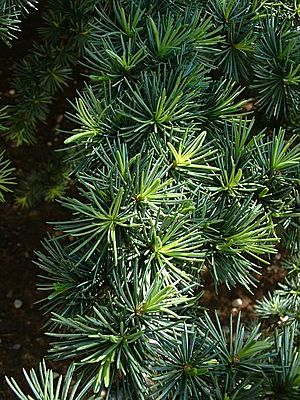Cedar facts for kids
Quick facts for kids Cedar |
|
|---|---|
 |
|
| Lebanon cedar in Al Shouf Cedar Nature Reserve, Barouk, Lebanon | |
| Scientific classification |
Cedrus, commonly known as the cedar, is a group of large, beautiful conifer trees. These trees are part of the Pinaceae family, which also includes pines and firs. Cedars naturally grow in the mountains of the western Himalayas and around the Mediterranean region. You can find them high up in the mountains, usually between 1,000 and 3,200 meters (about 3,300 to 10,500 feet) above sea level.
Contents
What Cedars Look Like
Cedar trees can grow very tall, often reaching 30–40 meters (about 100–130 feet), and sometimes even 60 meters (nearly 200 feet)! Their wood has a spicy, resin-like smell. They have thick bark that can be ridged or cracked into squares.
Cedars have two types of branches. There are long branches that form the main structure of the tree. Then there are shorter branches where most of the leaves grow. Their leaves are evergreen, meaning they stay green all year. They are like needles, 8–60 mm long. On the long branches, the needles are spread out in a spiral pattern. On the short branches, they grow in dense clusters of 15–45 needles together. The color of the needles can vary. They might be bright green, dark green, or even a pale blue-green. This blue-green color comes from a white, waxy layer that protects the leaves from drying out.
The seed cones of cedars look like barrels. They are 6–12 cm long and 3–8 cm wide. They start green and turn grey-brown as they get older. When the cones are ready, they break apart to release their winged seeds. These seeds are 10–15 mm long, with a wing that is 20–30 mm long. The seeds also have small blisters filled with a bad-tasting resin. This resin is thought to protect the seeds from animals like squirrels. It takes one year for a cone to fully grow. Pollination happens in the autumn, and the seeds are ready to be released the same time the following year. The pollen cones, which produce pollen, are slender and oval-shaped, 3–8 cm long. They appear in late summer and release pollen in the autumn.
Types of Cedars
Cedars are closely related to fir trees because their cones look very similar. Scientists group cedars into different types, or taxa, which are often considered different species or subspecies. Here are the main types:
| Image | Name | Common name | Where it grows | What it looks like |
|---|---|---|---|---|
 |
Cedrus atlantica | Atlas cedar | Atlas Mountains in Morocco and Algeria | Its leaves are dark green to bluish-green, 10–25 mm long. |
 |
Cedrus brevifolia | Cyprus cedar | Troodos Mountains in Cyprus | Its leaves are bluish-green, 8–20 mm long. |
 |
Cedrus deodara | Deodar or Himalayan cedar | Western Himalaya | Its leaves are bright green to pale green, 25–60 mm long. Its cones have slightly ridged scales. |
 |
Cedrus libani | Lebanon cedar | Mediterranean mountains in the Near East, Lebanon, and Turkey | Its cones have smooth scales.
|
Where Cedars Grow and Live
Cedars are well-suited to mountainous climates. In the Mediterranean, they get most of their rain as snow in winter and experience dry summers. In the western Himalaya, they mainly get summer monsoon rainfall and sometimes snow in winter. While some cedar species have been planted and now grow wild in the Americas, they are not originally from there.
Some Lepidoptera (moths and butterflies) species use cedars as a food source when they are larvae (caterpillars). For example, the pine processionary moth and the turnip moth have been seen feeding on deodar cedars.
How People Use Cedars

Cedars are very popular ornamental trees. This means people often plant them in gardens and parks because they look beautiful. They grow well in temperate climates where winter temperatures don't usually drop below about -25 °C (-13 °F). The Turkish cedar is a bit tougher and can handle temperatures down to -30 °C (-22 °F). However, many planted cedars can die in very harsh winters if it gets colder than that. Cedars have been successfully grown for a long time in places like the Mediterranean region, western Europe (including the British Isles), southern Australia and New Zealand, and parts of southern and western North America.
Cedar wood and cedarwood oil naturally keep moths away. Because of this, cedar wood is often used to line chests and closets where woolen clothes are stored. This use of cedar is very old. It is even mentioned in The Iliad, an ancient Greek story, where a king used a cedar-lined room to store treasures.
It's important to know that the "cedar" used for modern cedar chests in North America is actually a different type of tree called Juniperus virginiana, which is a kind of juniper. Cedarwood oil today often comes from various junipers and cypresses, which are in a different plant family called Cupressaceae. True cedars belong to the Cedrus genus. Cedar wood is also commonly used to make shoe trees. These are objects placed inside shoes to help them keep their shape, absorb moisture, and make them smell fresh.
Many types of cedar trees are also great for training as bonsai. Bonsai is the art of growing small trees that look like full-sized trees. Cedars work well for many bonsai styles, such as upright, slanting, and cascading.
Other pages





